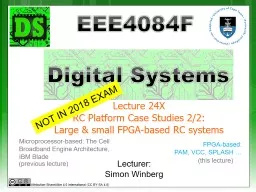

Lecturer Simon Winberg Digital Systems EEE4084F Lecture 24X RC Platform Case Studies 22 Large amp small FPGAbased RC systems Attribution ShareAlike 40 International CC BYSA 40 Microprocessorbased The Cell ID: 771333
Download Presentation The PPT/PDF document "Lecturer: Simon Winberg" is the property of its rightful owner. Permission is granted to download and print the materials on this web site for personal, non-commercial use only, and to display it on your personal computer provided you do not modify the materials and that you retain all copyright notices contained in the materials. By downloading content from our website, you accept the terms of this agreement.
Lecturer: Simon Winberg Digital Systems EEE4084F Lecture 24X RC Platform Case Studies 2/2: Large & small FPGA-based RC systems Attribution- ShareAlike 4.0 International (CC BY-SA 4.0) Microprocessor-based: The Cell Broadband Engine Architecture,IBM Blade FPGA-based: PAM, VCC, SPLASH … (this lecture) (previous lecture) NOT IN 2018 EXAM
Lecture Overview Large-scale FPGA-based RC system examplesPAM, VCC, Splash Small-scale FPGA-based RC system examplesPRISMAlgotronix CAL, XC620,Cray Research XD1, SRCSilicon Graphics RASP
Large-scale RC SystemsA look at platforms architectures
Large RC System - PAM Programmable Active Memories (PAM) Produced by Digital Equipment Corp (DEC) Used Xilinx XC3000 FPGAsIndependent banks of fast static RAM HostCPUFPGA FPGAFPGA FPGAFPGA FPGAFPGA FPGA SRAMSRAM SRAMSRAM SRAM SRAM SRAM SRAM DRAM Digital Equipment Corp. PAM system (1980s) Image adapted from Hauck and Dehon (2008) Ch3
Large RC System - VCC Virtual Computer Corporation (VCC) First commercially commercial RC platform*Checkerboard layout of Xilinx XC4010 devices and I-Cube programmable interconnection devicesSRAM modules on the edges * Hauck and Dehon (2008)… ……… ……… …… … …VCC Virtual Computer FPGA SRAM SRAM FPGA FPGA SRAM I-Cube FPGA FPGA FPGA I-Cube FPGA I-Cube I-Cube FPGA SRAM SRAM FPGA FPGA FPGA I-Cube I-Cube FPGA SRAM
Summary of the Splash system Developed initially to solve the problem of mapping the human genome and other similar problems. Design follows a reconfigurable linear logic array. The SPLASH aimed to give a Sun computer better than supercomputer performance for a certain types of problems. At the time, the performance of SPLASH was shown to outperform a Cray 2 by a factor of 325. FPGAs were used to build SPLASH, a cross between a specialized hardware board but more flexible like a supercomputer. The SPLASH system consists of software and hardware which plugs into two slots of a Sun workstation. ** Large RC System - Splash* Hauck and Dehon (2008) SRC Splash version 2Dedicatedcontroller … …… … SRAM FPGA FPGA SRAM FPGA SRAM FPGA SRAM FPGA SRAM FPGA SRAM FPGA SRAM Crossbar Dev. by Super Computer Research (SCR) Center ~1990 Well utilized (compared to previous systems ). Comprised linear array of FPGAs each with own SRAM * **Adapted from: Waugh, T.C., "Field programmable gate array key to reconfigurable array outperforming supercomputers," Custom Integrated Circuits Conference, 1991., Proceedings of the IEEE 1991 , vol., no., pp.6.6/1,6.6/4, 12-15 May 1991 doi : 10.1109/CICC.1991.164051 Illustration of the SPLASH design (adapted from *)
Small-scale RC SystemsA look at platforms architectures
Small RC Systems Brown University’s PRISMSingle FPGA co-processor in each computer in a clusterMain CPUs offloading parallelized functions to FPGAAlgotronix Configurable Array Logic (CAL) – FPGA featuring very simple logic cells (compared to other FPGAs)Later become XC6200 (when CAL bought by Xilinx) * Hauck and Dehon (2008)
Reconfigurable Supercomputers Cray ResearchXD1: 12 processing nodes6x ADM Opteron processors6x Reconfigurable nodes built from Xilinx Vertex 4Each XD1 in own chassis, can connect up to 12 chassis in a cabined (i.e. 144 processing nodes) SRCTraditional processor + reconfig. processing unitBased on Xilinx Virtex FPGAsSilicon GraphicsRASP (reconfigurable application-specific processor)Blade-type approach of smaller boards plugging into larger onesRef: Hauck and Dehon Ch3 (2008)
Additional Reading Reading ReconfigurableComputing: A Survey ofSystems and Software (ACM Survey) * * Compton & Hauck (2002) .“Reconfigurable Computing: A Survey of Systems and Software” I n ACM Computing Surveys, Vol. 34, No. 2, June 2002, pp. 171–210.(not specifically examined, but can help you develop insights that help you demonstrate a deeper understanding to problems)-- End of the Cell Processor case study --
Conclusion & Plans ReadingHauck, Scott (1998). “The Roles of FPGAs in Reprogrammable Systems” In Proceedings of the IEEE. 86(4) pp. 615-639.Next lecture: Amdahl’s LawDiscussion of YODA phase 1
Image sources:Wikipedia open commons Disclaimers and copyright/licensing details I have tried to follow the correct practices concerning copyright and licensing of material, particularly image sources that have been used in this presentation. I have put much effort into trying to make this material open access so that it can be of benefit to others in their teaching and learning practice. Any mistakes or omissions with regards to these issues I will correct when notified. To the best of my understanding the material in these slides can be shared according to the Creative Commons “ Attribution-ShareAlike 4.0 International (CC BY-SA 4.0)” license, and that is why I selected that license to apply to this presentation (it’s not because I particulate want my slides referenced but more to acknowledge the sources and generosity of others who have provided free material such as the images I have used).